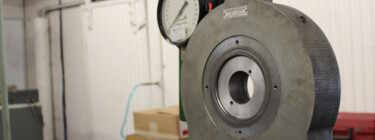Torque is a difficult value to calculate accurately, especially for construction fasteners and should be used cautiously. The primary challenge is accounting for environmental factors, coatings, and a number of other variables including surface texture, material hardness, and thread series. In most situations, it is challenging to give reliable allowable torque values for bolted assemblies. For the most accurate data we recommend field testing the intended assemblies using a calibrated torque wrench and a Skidmore-Wilhelm load indicating device to equate actual torque to the desired tension.
The theoretical torque values listed on our site are intended as reference point. This chart only covers products with a published friction coefficient.

I woud like to know the difference between the torque values of galvanized and non-glavanized A325 and A490 bolts.
@JabirAli – We have torque charts for both plain and galvanized (with wax) A325 bolts in the Technical Information section of our website.
Sir,
because of the continuous tightening and loosening of anchor bolt of my motor the thread of one leg got worn out. I did file to reduce the size of the bolt to its next near value and created a new thread of standard nearer value.
Now I need a new torque value for this newly formed thread anchor bolt. Could you please tell me how to calculate the torque for this?
I have data sheet of the anchor bolt provided by my supplier but he says he cannot provide me the value for the reduced thread.
Could you help me out!
@Santosh- normally for anchor bolts, snug tight is sufficient. If your application needs something special, we’d be unable to help as we do not have any engineers on staff.
I have heard a debate about torque being lost with the use of an extension bar. Example if I set my torque wrench to 50 ft lbs and use a foot long extension between the wrench and the socket, the applied torque will be less at the socket than if the socket were directly mounted to the wrench. Can you end this debate?
@Wayne- Torque is measured in foot-lbs, so the addition of an extension will make the wrench easier to turn, but shouldn’t effect the torque at the bolt head or nut. For example, if you are using a one foot long wrench, you would need to exert 50lbs of force to achieve 50ft-lbs of torque. If your wrench is two feet long, you would only need to exert 25lbs of force to achieve 50ft-lbs of torque. The torque in foot-lbs wouldn’t change because the length of the wrench is divided out.
I need to know what is the torque required for a A325 – 3/4″ STRUCTURAL BOLT for an inspection.
Can you give me this information or how we can determine that.
Thank you
@Jacques – There is no torque requirement for A325s, unless your engineer has specified one for this particular job. Normally what is desired is tension, and the tension for A325s is recommended to be 28,000-34,000lbs (28-34kips). You can derive the torque needed to achieve that tension, but the only sure fire way to do that is to do some field testing in a Skidmore-Whilhelm tension measuring device. Short of that, you are only guessing.
dear Sir,
could you please explain about nut Calculating Torque
thanks.
@Zeeshan – The FAQs we have on our website really explain it as well as we can. Torque is a tricky subject, and the variables with regards to friction and material make it hard to give any one standard answer.